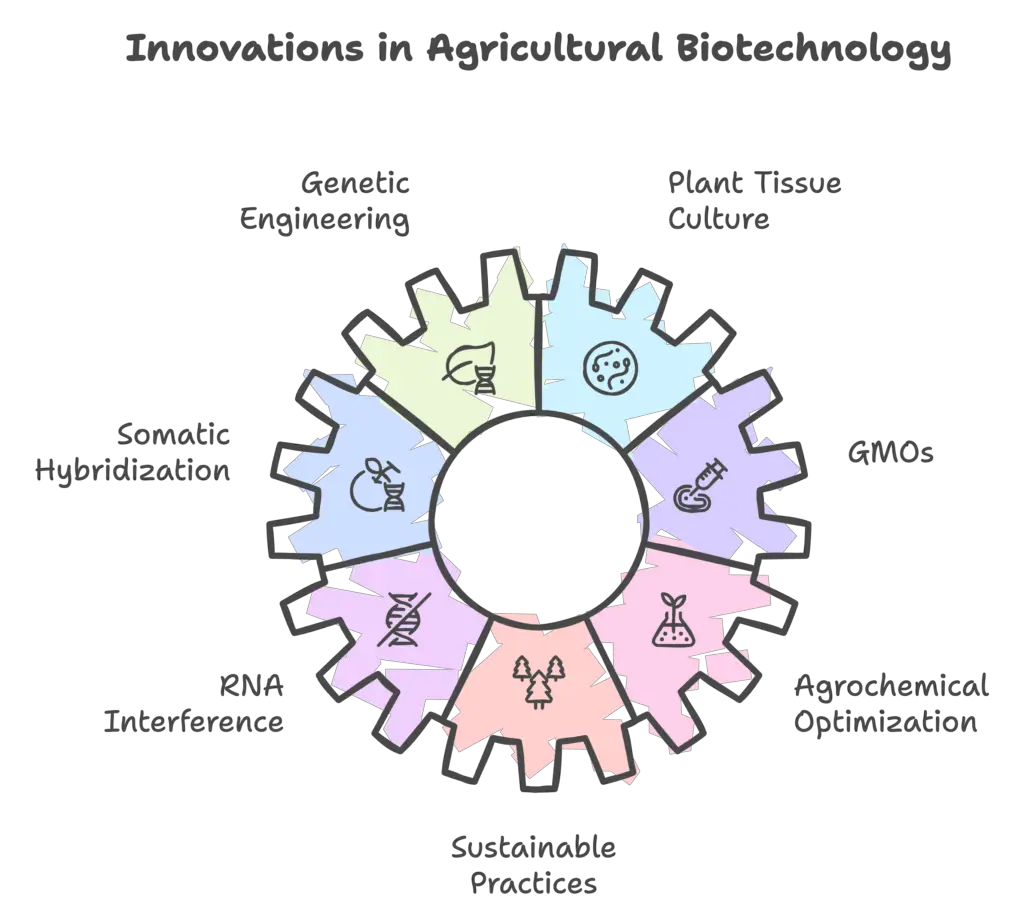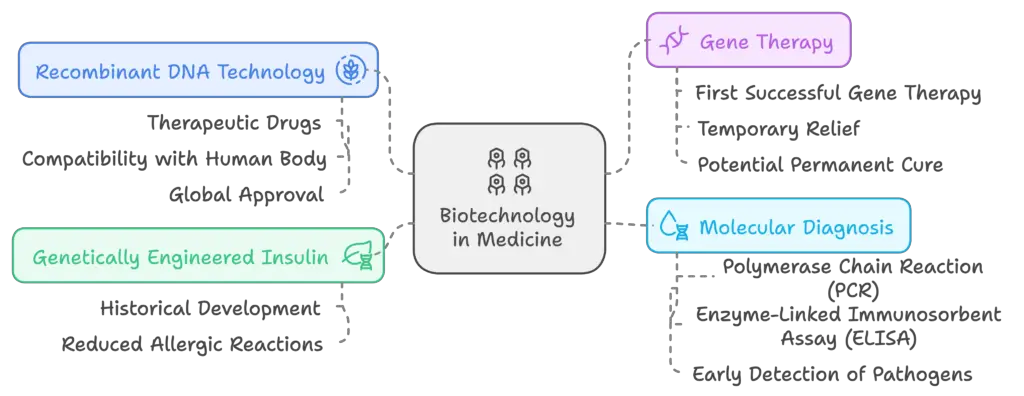What is Biotechnology?
Biotechnology is a broad field that involves the use of living organisms, cells, and biological systems to develop products and technologies that improve human life and the environment. It integrates knowledge from various scientific disciplines, including biology, chemistry, genetics, and engineering, to manipulate biological materials for specific applications. Here are some key aspects of biotechnology:
- Genetic Engineering: This involves modifying the genetic makeup of organisms to achieve desired traits, such as increased resistance to diseases or improved nutritional content in crops.
- Microbial Biotechnology: This branch focuses on the use of microorganisms, such as bacteria and fungi, for applications like fermentation, waste treatment, and the production of enzymes and biofuels.
- Medical Biotechnology: This area applies biotechnological techniques to develop medical products and therapies, including recombinant proteins, vaccines, and gene therapies for treating genetic disorders.
- Agricultural Biotechnology: This involves enhancing crop yield, resistance to pests and diseases, and improving nutritional quality through techniques such as transgenic crops and plant tissue culture.
- Environmental Biotechnology: This field uses bioprocesses to address environmental challenges, such as bioremediation, which utilizes microorganisms to clean up contaminated environments.
- Industrial Biotechnology: This focuses on the use of biological processes for manufacturing products, such as bioplastics, biofuels, and other sustainable materials.
Applications of Biotechnology in agriculture
The applications of biotechnology in agriculture, often referred to as Green Biotechnology or the Green Revolution, have profoundly reshaped farming practices globally. This approach seeks to enhance both the quality and quantity of food crops to meet the rising demand for agricultural products. Key figures such as Norman Borlaug and M.S. Swaminathan have played pivotal roles in this revolution, focusing on improved agricultural techniques, crop yields, and sustainable farming practices.

- Genetic Engineering in Crops: Genetic engineering serves as a cornerstone of modern agricultural biotechnology. By introducing specific genes into crops, scientists can develop varieties that exhibit desired traits such as pest resistance, enhanced nutritional content, and tolerance to environmental stresses. This genetic modification is crucial for increasing agricultural productivity.
- Plant Tissue Culture: Plant tissue culture, or micropropagation, involves cultivating plant cells or tissues in a controlled environment. This technique provides numerous benefits:
- Cloning: It allows for the precise duplication of plants that possess desirable traits, ensuring uniformity in crop production.
- Accelerated Growth: Plants can be matured rapidly, resulting in quicker harvest cycles.
- High-Density Cultivation: A significant number of plants can be grown in a limited space, optimizing land use.
- Pathogen-Free Production: Tissue culture techniques enable the regeneration of plants from genetically modified cells in sterile conditions, minimizing the risk of disease transmission.
- Seedless Propagation: This method permits the cultivation of plants that do not reproduce naturally through seeds.
- Somatic Hybridization: This process combines protoplasts from somatic cells of different plant species to create hybrid plants. This technique expands genetic diversity and can lead to the development of novel varieties with enhanced traits.
- Genetically Modified Organisms (GMOs): GMOs are organisms that have been genetically altered for specific agricultural advantages. These modifications often yield crops that are:
- Stress-Resilient: GMOs can withstand extreme weather conditions such as drought and frost, leading to more stable food production.
- Pest-Resistant: Crops engineered to express pest-resistant traits, such as Bt cotton, produce toxins that target specific insects without the need for chemical pesticides. The Bt toxin, derived from Bacillus thuringiensis, disrupts the digestive systems of pests, effectively protecting crops while promoting environmental sustainability.
- Nutritionally Enhanced: For instance, Golden Rice is biofortified with beta-carotene, addressing vitamin A deficiencies in populations reliant on rice as a staple food.
- RNA Interference (RNAi): This innovative technique exploits the natural defense mechanisms of cells to silence specific genes associated with pest resistance. By introducing complementary RNA sequences into host plants, RNAi can inhibit the translation of targeted messenger RNA (mRNA) in pests such as the root-knot nematode, Meloidogyne incognita. This approach significantly reduces crop damage and enhances yields without relying heavily on chemical treatments.
- Agrochemical Optimization: Biotechnology enables the development of more efficient agrochemicals that improve soil fertility and reduce environmental impact. For instance, biopesticides and biofertilizers, derived from natural organisms, enhance crop resilience while promoting ecological balance.
- Sustainable Practices: The incorporation of biotechnology in agriculture contributes to sustainable farming practices by reducing chemical usage, lowering production costs, and enhancing food security. This aligns with global efforts to address food scarcity and promote environmental health.
Applications of Biotechnology in Medicine
The applications of biotechnology in medicine represent a revolutionary advancement in healthcare, facilitating the development of innovative therapies and diagnostic tools. Through processes such as recombinant DNA technology, gene therapy, and molecular diagnosis, biotechnology has significantly enhanced the efficacy and safety of medical treatments. This overview elucidates several key applications of biotechnology in medicine.

- Recombinant DNA Technology: This technology has transformed the production of therapeutic drugs, allowing for the mass production of safe and effective recombinant therapeutics. Unlike products sourced from animals, which can provoke unwanted immune responses, recombinant therapeutics are designed to be more compatible with the human body. Currently, approximately 30 recombinant therapeutics have received global approval for human use, with 12 available in India alone.
- Genetically Engineered Insulin: The management of diabetes has been revolutionized through the development of genetically engineered insulin. Previously, insulin was extracted from the pancreases of cattle and pigs, often leading to allergic reactions in patients due to foreign proteins. Genetically engineered bacteria can produce human insulin, ensuring its efficacy and reducing the risk of immune responses. In 1983, Eli Lilly successfully introduced DNA sequences corresponding to the A and B chains of human insulin into plasmids of Escherichia coli. These bacterial cultures produced the insulin chains separately, which were then combined through disulfide bonds to yield functional human insulin.
- Gene Therapy: Gene therapy aims to correct hereditary diseases by delivering functional genes to replace non-functional ones. This technique is particularly important for diseases caused by genetic defects. The first successful clinical gene therapy occurred in 1990 for a child with adenosine deaminase (ADA) deficiency, a condition impairing immune function. In this procedure, lymphocytes from the patient were cultured, and a functional ADA gene was introduced using a retroviral vector before reintroducing the modified cells back into the patient. While this treatment provides temporary relief, introducing the functional gene at early embryonic stages could potentially offer a permanent cure.
- Molecular Diagnosis: Early diagnosis is critical for effective treatment, and biotechnology plays a crucial role in enhancing diagnostic capabilities. Traditional diagnostic methods often fail to detect diseases until symptoms manifest, which can delay treatment. Advanced techniques such as Polymerase Chain Reaction (PCR) and Enzyme-Linked Immunosorbent Assay (ELISA) enable the early detection of pathogens and genetic disorders.
- PCR amplifies very low concentrations of DNA, allowing for the identification of pathogens like HIV even before symptoms appear. This technique is invaluable in diagnosing various genetic disorders by detecting mutations in genes associated with diseases.
- ELISA utilizes the principle of antigen-antibody interactions to identify infections. By detecting specific antigens or antibodies related to a pathogen, ELISA provides a rapid and reliable method for diagnosing infectious diseases.
- Broad Implications of Biotechnology: The integration of biotechnology into medicine has not only improved the treatment of existing diseases but has also facilitated the development of targeted therapies, enhancing patient care. Additionally, these advancements contribute to the overall understanding of disease mechanisms and promote personalized medicine approaches, where treatments can be tailored to the genetic profiles of individual patients.
Transgenic animals
Transgenic animals, defined as organisms whose DNA has been altered to include and express an additional foreign gene, have emerged as crucial tools in modern biological research and medicine. While a variety of transgenic species, including rats, rabbits, pigs, sheep, cows, and fish, have been produced, the majority—over 95%—are mice. This substantial representation is due to their well-characterized genetics, ease of manipulation, and quick reproduction cycles. The development and utilization of transgenic animals are primarily driven by several key factors:
- Understanding Normal Physiology and Development: Transgenic animals provide invaluable insights into gene regulation and its impact on physiological functions and development. By introducing genes from other species, researchers can study how these modifications affect biological processes, such as the role of insulin-like growth factor in growth. This approach enables scientists to discern complex biological interactions and regulatory mechanisms within the body.
- Modeling Human Diseases: One of the most significant applications of transgenic animals is in the study of human diseases. These specially engineered models mimic various health conditions, allowing researchers to investigate the genetic contributions to diseases such as cancer, cystic fibrosis, rheumatoid arthritis, and Alzheimer’s disease. By understanding the underlying genetic factors, new treatments and therapeutic strategies can be developed, leading to potential breakthroughs in medical science.
- Production of Biological Products: Transgenic animals can be engineered to produce valuable biological products, thereby reducing the costs associated with the manufacture of medicines. For instance, specific genes can be introduced to enable these animals to synthesize human proteins, such as α-1-antitrypsin, which is used in treating emphysema. A notable example is Rosie, the first transgenic cow, which produced milk enriched with human alpha-lactalbumin, making it nutritionally more suitable for human infants compared to traditional cow’s milk. This innovation demonstrates the potential for transgenic animals to contribute to healthcare solutions.
- Vaccine Safety Testing: The development of transgenic mice for vaccine safety testing represents another significant application. These genetically modified mice can serve as models to assess the safety of vaccines, such as the polio vaccine, before they are administered to humans. Utilizing transgenic mice can potentially replace the use of primates in vaccine testing, providing a more ethical and efficient approach to evaluating vaccine safety.
- Chemical Safety Testing: Transgenic animals are also utilized in toxicity and safety testing of chemical substances. By incorporating genes that increase sensitivity to toxins, these animals can be exposed to various chemicals, allowing researchers to monitor and analyze their effects. This methodology can accelerate the toxicity testing process, yielding results more quickly than traditional methods while ensuring more accurate safety assessments.
- Text Highlighting: Select any text in the post content to highlight it
- Text Annotation: Select text and add comments with annotations
- Comment Management: Edit or delete your own comments
- Highlight Management: Remove your own highlights
How to use: Simply select any text in the post content above, and you'll see annotation options. Login here or create an account to get started.